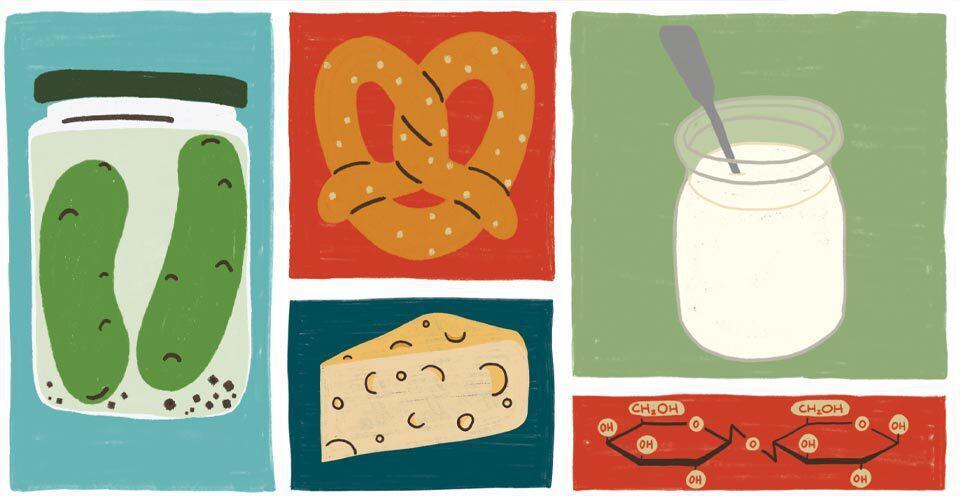New Fermentation Major Will Support Growing Maryland Craft Beverage and Food Industries
By Chris Carroll | Illustrations by Valerie MorganWine and cheese. Beer and sourdough pretzels. Brats heaped with sauerkraut.
None of these delightful combinations would exist without the bubbling biological process of fermentation, in which yeast and other microorganisms themselves chow down on nutrients like sugars, fats and proteins to transform food into something magical—or at least, savory.
And now there’s a new pairing: the University of Maryland and an undergraduate major in fermentation science.
Offered by the College of Agriculture and Natural Resources (AGNR) both in College Park and at the Universities at Shady Grove, the four-year major debuting this fall will increase knowledge around this ancient way to prepare and preserve food, while giving students the knowledge to turn it to newer uses like climate-friendly biofuels and pharmaceutical development. Not least, it aims to boost a range of homegrown craft food and drink industries, from the distilleries quickly multiplying around Maryland to longstanding cheese makers.
If that sounds a bit Food Network-y, or like a good course of study to avoid math headaches, sorry—the “science” part of the name is for real.
“This is very much a STEM (science, technology, engineering, mathematics) major, with quite a bit of chemistry, microbiology and math in it,” says Frank Coale, AGNR professor and assistant dean for strategic initiatives who led the development of the new track. “It will give students a very good background in the biological sciences and will even prepare them to apply for medical school, if that’s what they want.”
Surveys of students who took an AGNR course on the history of fermentation suggest that what they really want is to work with fermented dairy products—think yogurt, kefir and cheese—followed by wine and sourdough. Perhaps surprisingly for college students, beer fell further down the list of favored study topics, after pharmaceuticals and fermented meat products like naturally cured sausage and tied with probiotics.
While laying the groundwork to propose the major, Coale found widespread enthusiasm among Maryland food, beverage and agriculture producers, along with a willingness to contribute their hard-earned knowledge.
Fermentation has been vital to human survival since prehistory—preserving milk, meat and grain for winter, or creating mildly alcoholic drinks safer than polluted water sources—but having a UMD major will inject new ideas and train a workforce of experts, says Mike Koch, co-founder and president of FireFly Farms, a Garrett County cheese maker.
“We could not be more supportive of the university efforts to stand up this program,” he says. “It helps in the long run to create the same sort of energy that has started around cheese making in Vermont, upstate New York or Wisconsin, where the land-grant universities have invested a lot in cheese making.”
Max Hames, distillery operations manager of Sagamore Spirit, a Baltimore-based rye whiskey distiller founded by Kevin Plank ’96, says fermentation scientists could help delve into the subtleties of interactions of microorganisms and food sources in fermentation tanks that can help separate a good whiskey from a great one.
“We’re not doing straightforward yeast fermentation—there are a lot of different creatures at work,” Hames says. “We’re always dialing in our fermentations on a day-to-day range, and having a solid understanding of what’s going on in all that complexity is important.”
Two AGNR departments—Nutrition and Food Science, and Plant Science and Landscape Architecture—will collaborate to offer the major. Plant science’s domain is the raw material for fermentation: grains for bread and beer and vegetables used in sauerkraut or pickles, says department chair and Professor John Erwin.
He appreciates good wine, and he says he sometimes has to ask sellers or café owners why they’re not stocking vintages from Maryland’s wine industry, which has grown rapidly in the 21st century to more than 100 wineries.
“I think we in Maryland can do as good a job, or better, of producing all these products as other places,” he says, adding that in addition to specialty food producers, the fermented corn stalk silage is also an important source of livestock feed on traditional farms.
How fermentation produces food—and managing food safety issues—is the domain of the nutrition and food science department, says its chair, Professor Cheng-I Wei.
The four-year major, one of only a small handful nationwide in fermentation science, is intensively multidisciplinary, and Wei says he hopes collaborations develop with the Robert H. Smith School of Business, the A. James Clark School of Engineering and others. The surveyed students also have widely divergent interests within the major.
“Some are very business-oriented and might want to run wineries and host agritourism; others want to improve operations of their family farms and produce good-quality agricultural products for these uses,” he says. “Some are just interested in making good products: the wine or cheese—maybe kimchi.”
Issue
Winter 2022Types
Campus Life